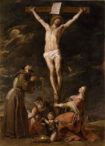“Why white?” That question greeted me as soon as I walked into the choir room on Sunday morning before Mass.
Good question. According to the calendar, the Sunday was the 17th after Pentecost, and the liturgical color would be green, but the servers had already put white on the altar and tabernacle. Why so?
Earlier in the week, on September 15th, the Church celebrated the feast of Our Lady of Sorrows. This feast, not surprisingly, comes immediately after the feast of the Holy Cross, and these two feasts are what give rise to the dual devotions for the month of September – The Holy Cross and Our Lady of Sorrows.
Of course, the great patron and name Saint of the Priestly Fraternity of Saint Pius X (the SSPX) is the sainted Pope himself. But the SSPX has also chosen Our Lady of Sorrows as a patron. Thus, within the SSPX, the Feast of Our Lady of Sorrows is a first-class feast, and so the feast can be solemnized on the following Sunday and is celebrated as what is referred to as an external solemnity.
Then came the follow-up question: “Well, then, why not violet?” Well, because violet is not fitting for a first-class feast! And that brings up another interesting point. The feast of Our Lady of Sorrows is very unique in that there are two such feasts, the first of which is on the Friday of Passion Week, one week before Good Friday and rather like Our Lady’s own Good Friday. At that Mass, the liturgical color is violet.
The feast of Our Lady of Sorrows is also unique in that it is one of only five Masses that still has a Sequence. The five are:
- Pentecost (Veni Sancte Spiritus)
- Corpus Christi (Lauda Sion)
- Our Lady of Sorrows (Stabat Mater)
- Easter (Victimae Paschali Laudes)
- Requiem (Dies Irae)
For the feast that occurs during Passiontide, the Sequence is preceded by the Gradual, and a Tract. Naturally, there is no Alleluia. For this feast, the Sequence is preceded by the Gradual and an Alleluia. Note as well that when the Sequence is sung outside of Lent, the word Alleluia is appended after the Amen.
As you might expect, we chose Mass IX, for feasts of the Blessed Virgin (Cum Jubilo) for the commons. And a Credo that works very nicely with Mass IX is Credo III.
Having missed the opportunity last week, as the Processional hymn, we sang I’ll Sing a Hymn to Mary, in honor of her holy name. This is particularly fitting because it twice makes a reference to loving and blessing the name of Mary.
We again invoked Our Lady at the Offertory with Stella Coeli Extirpavit, imploring her intercession to end the current pestilence.
At the Communion, the mixed choir sang Tomas Luis Victoria’s setting of O Vos Omnes. This hymn is taken from a responsory from Tenebrae of Holy Saturday. It is utterly pathetic, perfect for the occasion:
O all you who walk by on the road, pay attention and see if there be any sorrow like my sorrow.
Pay attention, all people, and look at my sorrow, if there be any sorrow like my sorrow.
With a bit of time remaining, we sang the Gregorian Ave Maria twice through.
Also earlier in the week, we had the feast of the Stigmata of St. Francis of Assisi. St. Francis is also unique in that he is among the very few who have more than one feast during the year. Others include: Our Lord, Our Lady, John the Baptist, and Saint Joseph. As a Recessional Hymn, we sang Blessed Francis, Holy Father in his honor.
After Mass, as the Faithful made their thanksgiving, we sang the Vexilla Regis, vespers hymn from Passiontide and from the Feast of the Holy Cross.









